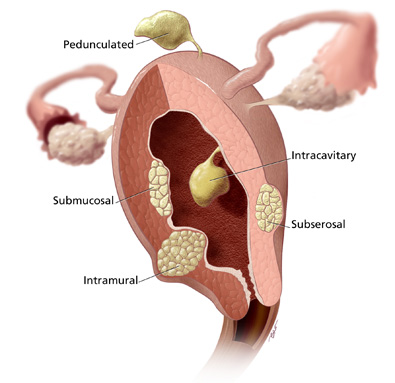da Vinci® Myomectomy
da Vinci® Myomectomy
If you’ve been diagnosed with fibroid tumors, your doctor may recommend a myomectomy. With a myomectomy procedure, your surgeon removes the fibroids and not your uterus. If you are considering surgery, ask your doctor about minimally invasive da Vinci Myomectomy.
Why da Vinci Myomectomy?
With the da Vinci System, surgeons operate through a few small incisions instead of a large open incision – similar to traditional laparoscopy. The da Vinci System features a magnified 3D high-definition vision system and special wristed instruments that bend and rotate far greater than the human wrist. As a result, da Vinci enables your surgeon to operate with enhanced vision, precision, dexterity and control.
As a result of the da Vinci technology, da Vinci Myomectomy offers the following potential benefits compared to traditional open surgery:
- Less blood loss1,2,3
- Shorter hospital stay1,2,3,4
- Less need for narcotic pain medicine4
- Small incisions for minimal scarring5
As a result of the da Vinci technology, da Vinci Myomectomy offers the following potential benefits when compared to traditional laparoscopy:
- Minimally invasive removal of heavier, more numerous and more difficult to access fibroids1
- Fewer complications during surgery6
State-of-the-art da Vinci uses the latest in surgical and robotics technologies and is beneficial for performing complex surgery. Your surgeon is 100% in control of the da Vinci System, which translates his or her hand movements into smaller, more precise movements of tiny instruments inside your body. da Vinci – taking surgery beyond the limits of the human hand.
Physicians have used the da Vinci System successfully worldwide in approximately 1.5 million various surgical procedures to date. da Vinci – changing the experience of surgery for people around the world.
Risks & Considerations Related to Myomectomy & da Vinci Surgery
Potential risks of any myomectomy procedure, including da Vinci Surgery include:6
- Wound infection
- Injury to nearby organ (bowel)
- Pelvic abscess
PN 1002186 Rev B 04/2014
- Barakat EE, Bedaiwy MA, Zimberg S, Nutter B, Nosseir M, Falcone T. Robotic-assisted, laparoscopic, and abdominal myomectomy: a comparison of surgical outcomes. Obstet Gynecol. 2011 Feb;117(2 Pt 1):256-65.
- Ascher-Walsh CJ, Capes TL. Robot-assisted laparoscopic myomectomy is an improvement over laparotomy in women with a limited number of myomas. J Minim Invasive Gynecol. 2010 May-Jun;17(3):306-10. Epub 2010 Mar 19.
- Sangha R, Eisenstein D, George A, Munkarah A, Wegienka G. Surgical outcomes for robotic-assisted laparoscopic myomectomy compared to abdominal myomectomy. Journal of Robotic Surgery, Volume 4, Number 4, December 2010 , pp. 229-233(5).
- Nash K, Feinglass J, Zei C, Lu G, Mengesha B, Lewicky-Gaupp C, Lin A. Robotic-assisted laparoscopic myomectomy versus abdominal myomectomy: a comparative analysis of surgical outcomes and costs. Arch Gynecol Obstet. 2012 Feb;285(2):435-40. Epub 2011 Jul 22.
- Advincula AP, Song A, Burke W, Reynolds RK. Preliminary experience with robot-assisted laparoscopic myomectomy. J Am Assoc Gynecol Laparosc.2004 Nov;11(4):511-8 (see figure 2). Alternatively, see Myomectomy Procedure Guide, PN 871798.
- Bedient CE, Magrina JF, Noble BN, Kho RM. Comparison of robotic and laparoscopic myomectomy. Am J Obstet Gynecol. 2009 Dec;201(6):566.e1-5. Epub 2009 Aug 15.
Serious complications may occur in any surgery, including da Vinci® Surgery, up to and including death. Examples of serious or life-threatening complications, which may require prolonged and/or unexpected hospitalization and/or reoperation, include but are not limited to, one or more of the following: injury to tissues/organs, bleeding, infection and internal scarring that can cause long-lasting dysfunction/pain. Risks of surgery also include the potential for equipment failure and/or human error. Individual surgical results may vary.
Risks specific to minimally invasive surgery, including da Vinci Surgery, include but are not limited to, one or more of the following: temporary pain/nerve injury associated with positioning; temporary pain/discomfort from the use of air or gas in the procedure; a longer operation and time under anesthesia and conversion to another surgical technique. If your doctor needs to convert the surgery to another surgical technique, this could result in a longer operative time, additional time under anesthesia, additional or larger incisions and/or increased complications.
Patients who are not candidates for non-robotic minimally invasive surgery are also not candidates for da VinciSurgery. Patients should talk to their doctor to decide if da Vinci Surgery is right for them. Patients and doctors should review all available information on non-surgical and surgical options in order to make an informed decision. For Important Safety Information, including surgical risks, indications, and considerations and contraindications for use, please also refer to www.davincisurgery.com/safety and www.intuitivesurgical.com/safety. Unless otherwise noted, all people depicted are models.





